The first English settler to successfully cultivate tobacco in Virginia, John Rolfe famously married Powhatan "princess" Pocahontas in 1614.
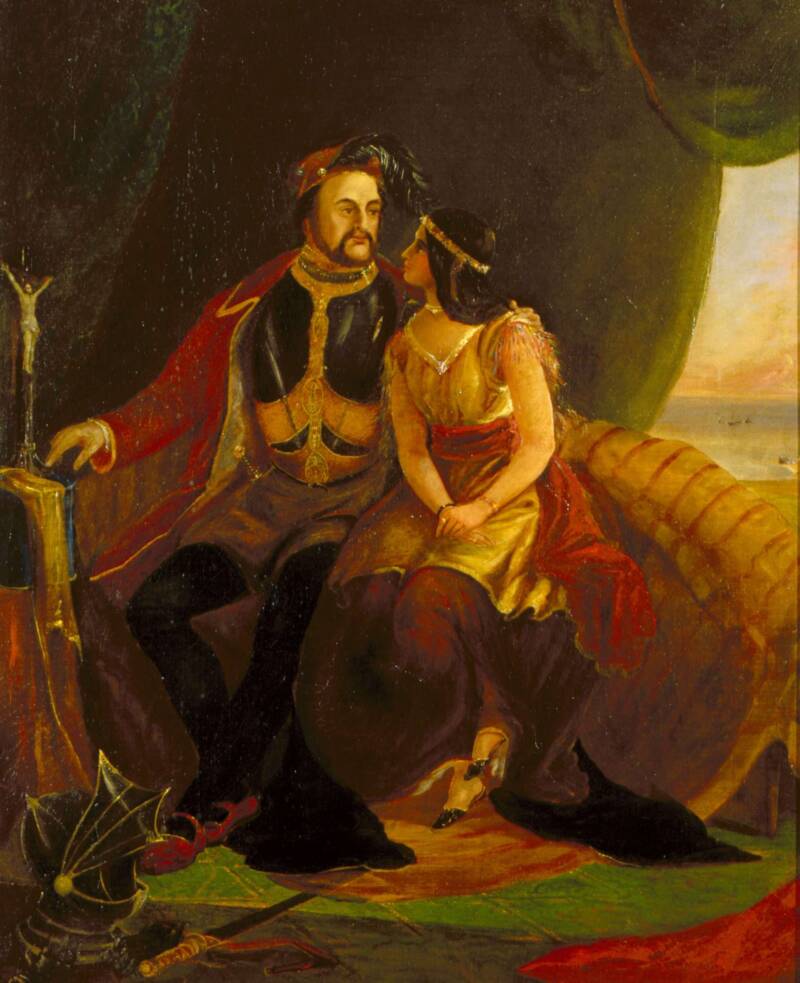
Virginia Historical SocietyA 19th-century depiction of John Rolfe and Pocahontas by James William Glass Jr.
Some years after his arrival in Jamestown, English settler John Rolfe began to struggle with a question of the heart. He’d fallen in love with a “heathen” named Pocahontas, who was held captive by his fellow colonists. In the end, Rolfe decided to marry Pocahontas — the daughter of Chief Powhatan — thus forever cementing their relationship into history.
But their “love story” was far more complicated than it may seem. Indeed, there’s a reason why Disney decided to focus on Pocahontas’ rescue of the colonist John Smith, instead of her marriage to John Rolfe, in the 1995 animated movie Pocahontas. Even the 1998 sequel Pocahontas II, which introduced John Rolfe as Pocahontas’ love interest, took many creative liberties with the relationship between the two characters.
So who was John Rolfe? How did he cross paths with Pocahontas, and what were the true circumstances of their relationship? Here’s everything you need to know about the man who became Pocahontas’ husband.
John Rolfe’s Tumultuous Voyage To The New World
John Rolfe was born around 1585 in Norfolk, England, but much of his early life has been lost to time. He reappeared in the historical record in May 1609, when he and his first wife, Sarah Hacker, boarded a ship called the Sea Venture. They set sail for the New World as part of a larger convoy.
Rolfe and his wife were part of a mission to revive Jamestown — the first permanent English settlement in North America — which had struggled since its foundation in 1607. But they almost didn’t survive the crossing. In July, their convoy sailed into a hurricane, which broke up the fleet, and marooned the Sea Venture’s 150 passengers and crew members in Bermuda.
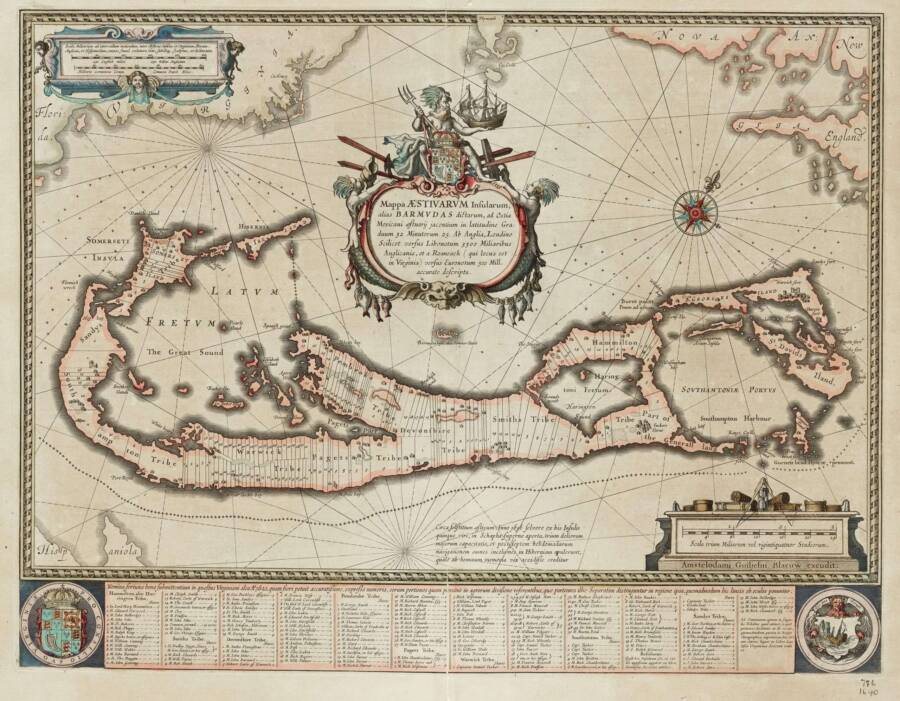
The Mariners’ MuseumA map of Bermuda from 1640.
“For foure and twenty houres the storme in a restlesse tumult, had blowne so exceedingly, as we could not apprehend in our imaginations any possibility of greater violence, yet did wee still finde it, not onely more terrible, but more constant, fury added to fury, and one storme urging a second more outragious then the former,” wrote passenger William Strachey, the future secretary of the Virginia colony.
The shipwreck turned out to be serendipitous for the Sea Venture’s passengers. While Rolfe and the other survivors of the Sea Venture thrived thanks to Bermuda’s impressive supply of food, the ships that made it to Virginia fared much worse. They struggled to survive the so-called Starving Time, during which some three-quarters of English settlers perished due to starvation.
That said, Rolfe suffered a personal tragedy while marooned on the island. His wife, Sarah, gave birth to a baby girl who they named Bermuda — but the infant sadly did not survive long. Shortly afterward, Sarah died too.
By the spring of 1610, the survivors of the Sea Venture were ready to complete their voyage to Virginia. They’d constructed two ships — the Patience and the Deliverance — from island cedar trees and what they could salvage from their original vessel. After sailing for about 10 days, they reached the Chesapeake Bay and arrived at Jamestown soon afterward.
In the Virginia colony, John Rolfe soon distinguished himself through his experiments with tobacco. He’s credited as the first colonist to plant tobacco seeds in the region. Rolfe had obtained them somewhere in the Caribbean, and his friends approvingly noted that the crop “smoked pleasant, sweete and strong.”
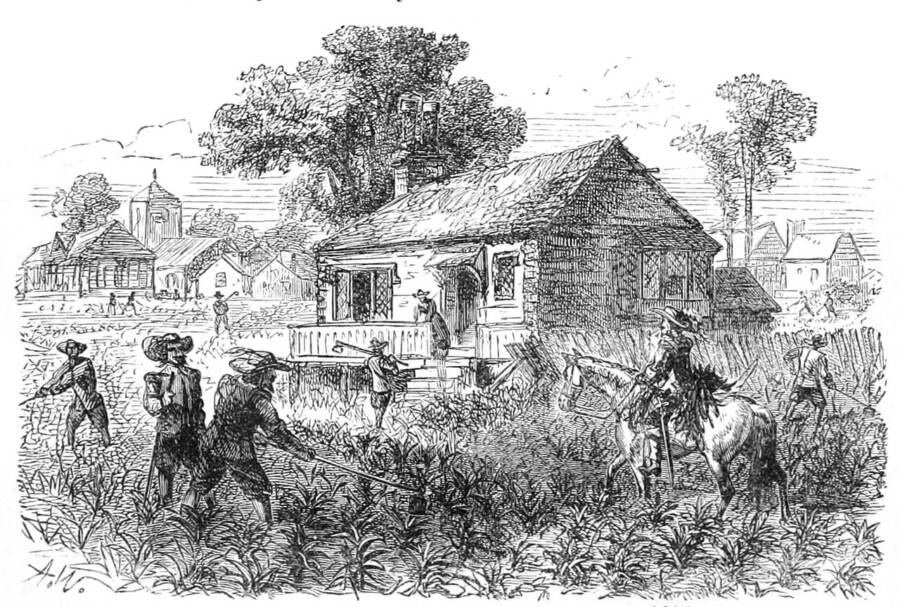
Public DomainA 19th-century depiction of Jamestown colonists growing tobacco.
But Rolfe is not remembered only for cultivating tobacco. He’s mostly remembered for his marriage to Pocahontas, a Powhatan Native American.
The Controversial “Love” Story Of John Rolfe And Pocahontas
The colonists’ relationship with the Powhatan people predated John Rolfe’s arrival by a few years. In 1607, shortly after Jamestown was established, colonist John Smith was captured by the tribe. He was paraded from town to town, and then brought before the tribe’s leader, Chief Powhatan.
Smith later claimed that he was thrown down before the chief and nearly bludgeoned to death, but he was saved at the last minute by an unlikely ally: Powhatan’s 11-year-old daughter, Pocahontas. But in reality, Smith might not have been in danger at all — he might have confused a tribal adoption ritual for an execution. Still, Smith’s encounter with the Powhatan marked the beginning of the tribe’s relationship with the English colonists.
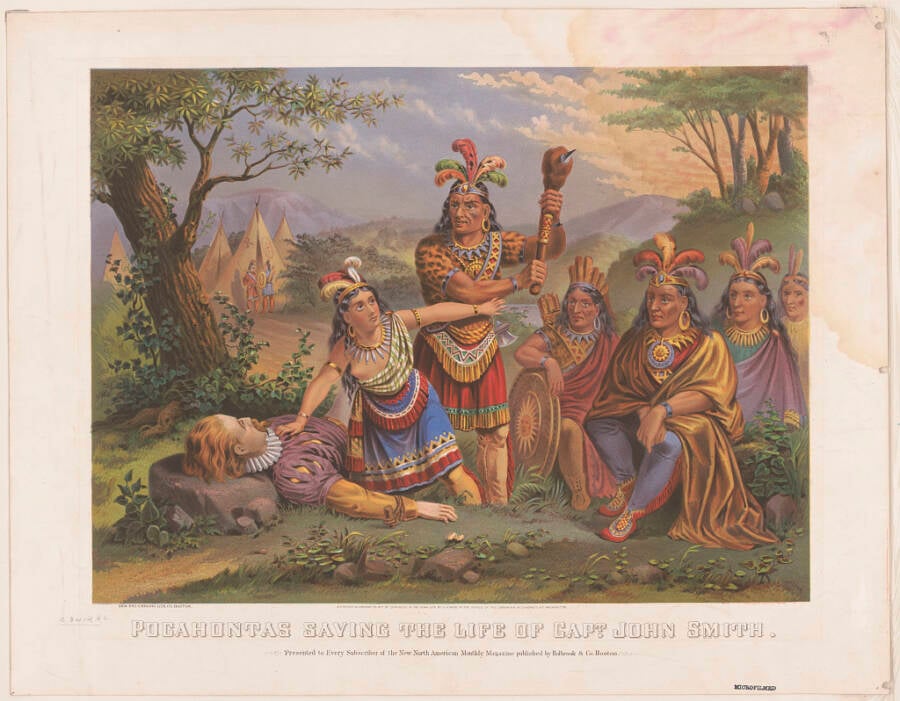
Library of CongressJohn Smith’s encounter with Pocahontas is famous, but often misunderstood.
After John Rolfe arrived in 1610, however, the colonists’ relationship with the Powhatans had soured — especially as the settlers began demanding more supplies from the Powhatan people. And in 1613, Captain Samuel Argall hatched a plot to kidnap the chief’s daughter to hold her for ransom.
Pocahontas, then around 17 years old, was kidnapped and brought to Jamestown. Some tribal oral traditions claim that she was raped by an unidentified colonist while in captivity and impregnated against her will. (This is the story that Pocahontas allegedly told her sister, Mattachanna, according to the National Park Service.) English sources, however, paint a more idyllic picture of Pocahontas peacefully learning English, converting to Christianity, and eventually taking on the new name “Rebecca.”
During this time, Pocahontas also crossed paths with John Rolfe. Before long, Rolfe developed an ardent desire to marry her, which he expressed in a long letter to the colonial governor Thomas Dale in 1614.
“[It is to Pocahontas] to whom my hearty and best thoughts are, and have a long time been so entangled,” Rolfe wrote, “and enthralled in so intricate a labyrinth, that I was even awearied to unwind myself thereout.”
But did Rolfe really want to marry Pocahontas for love? The National Park Service suggests that he may have been motivated to marry her in order to help his tobacco crops. By marrying Pocahontas, Rolfe could get the help of Indigenous priests who oversaw the growing of tobacco in the area. And Rolfe himself promised Dale in his letter that he was not driven to marry Pocahontas by “the unbridled desire of carnal affection: but for the good of this plantation, for the honor of our country, for the glory of God.”
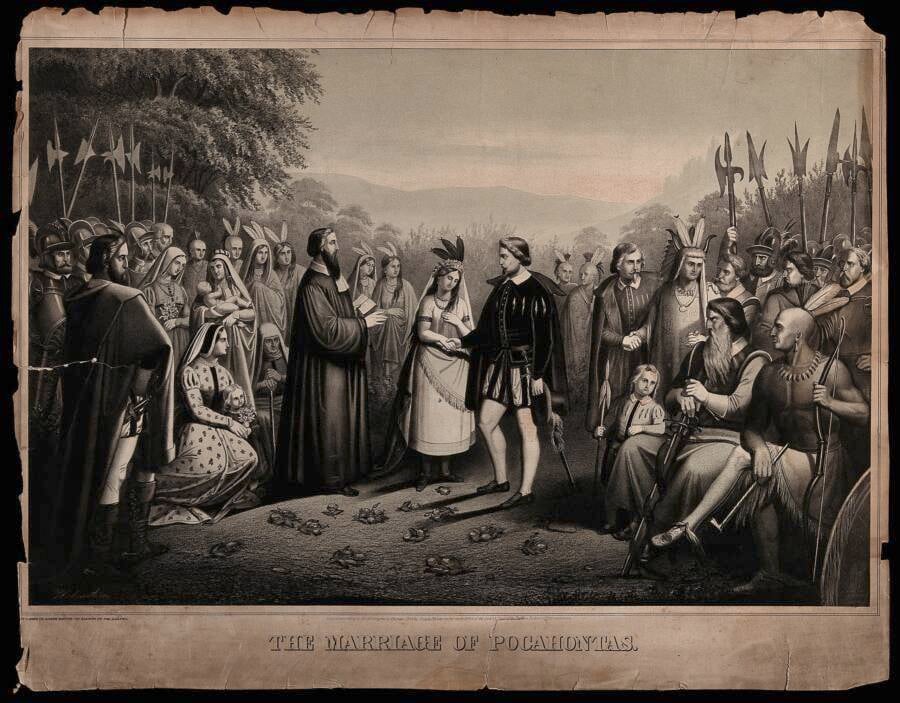
Wellcome ImagesJohn Rolfe married Pocahontas in 1614, though his motivations for doing so are debatable.
Pocahontas and John Rolfe were married on April 5, 1614. However, whether she or her father truly consented to the marriage is difficult to discern. With Pocahontas as a captive, they may not have had the freedom to decline.
In any case, John Rolfe and Pocahontas’ wedding would usher in an age of relative peace between the colonists and the Powhatan people. But the couple’s union would prove to be tragically short-lived.
Pocahontas’ Mysterious Death In England
At some point, Pocahontas welcomed a son, Thomas Rolfe. English accounts state that Pocahontas gave birth after marrying John Rolfe, but tribal oral traditions say that she had her son before the wedding.
In 1616, the Virginia Company of London — which had financed the establishment of Jamestown — paid for John Rolfe, Pocahontas, and Thomas Rolfe to travel to England. The company believed that Pocahontas would serve as an example of the colony’s success in “civilizing” an Indigenous person, showing her off as a “tamed savage” and a Powhatan “princess” (despite the fact that she wasn’t actually considered a princess in Powhatan culture). Sadly, Pocahontas would never return home.
At first, the trip seemed to go well. John Rolfe and Pocahontas (then known as “Lady Rebecca Rolfe”) spent months touring the country. Pocahontas was presented at the court of King James I, and she attended a masque where she and Rolfe sat near the king and his wife, Queen Anne.
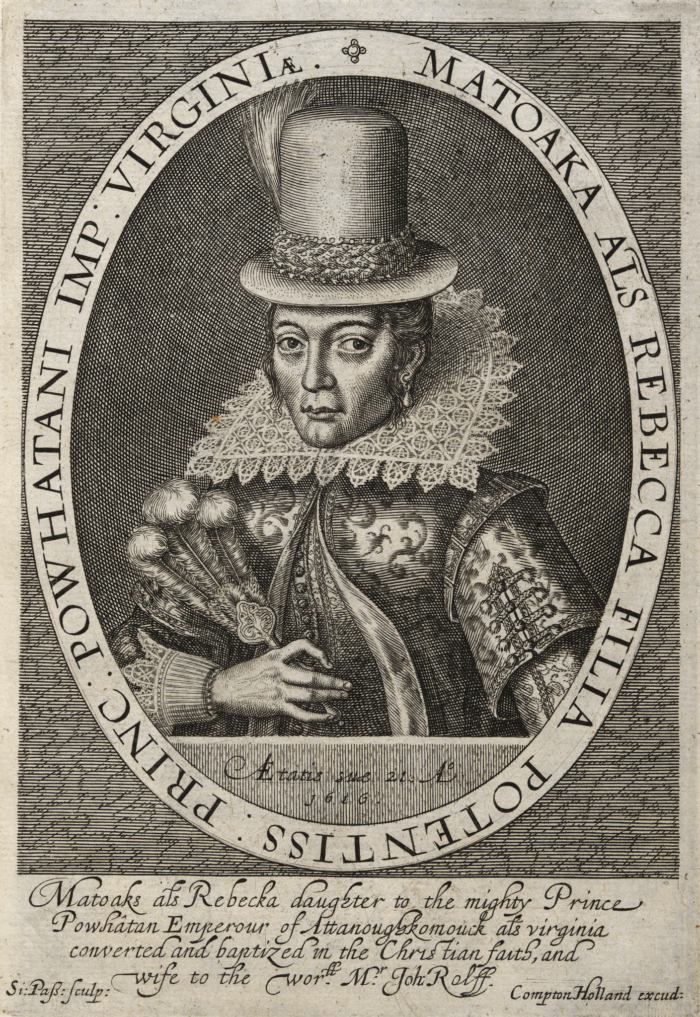
Public DomainA 1616 engraving of Pocahontas, who traveled through England as “Lady Rebecca Rolfe.”
But as the young family prepared to return to Virginia, tragedy struck. Early on in their voyage back to Jamestown, Pocahontas suddenly fell ill in March 1617 and died around the age of 21. She was later buried in the town of Gravesend, England, near St. George’s Church. But what had killed her?
To date, her cause of death is unknown (as is the exact location of her burial). Though some claim that Pocahontas died because of an upper respiratory ailment or an illness like smallpox or dysentery, others believe that she was deliberately poisoned because of how quickly she fell ill and died. Sadly, the truth about her death will probably never be known.
In any case, John Rolfe found himself a widower for the second time after Pocahontas’ death. Concerned about his son Thomas — who had also fallen ill — John left the boy with a relative in England and returned to Virginia alone. Though Thomas recovered, he would never see his father again.
John Rolfe’s Final Years In The New World
Upon his return, John Rolfe dedicated himself to the growth of Virginia. He became a councilor and a member of the House of Burgesses, and continued to cultivate tobacco. The exportation of Virginia tobacco to England swiftly ramped up. In 1617, exports totaled 20,000 pounds. The next year, tobacco exports more than doubled.
Rolfe also married for the third time, this time to a woman named Jane Pierce (sometimes spelled Pearce), the daughter of Captain William Pierce.
But even though Rolfe’s personal and professional life appeared to be thriving, the mood in the New World was darkening. The peace established between Indigenous people and colonists by John Rolfe and Pocahontas’ marriage had started to break down, especially after the death of Pocahontas’ father in 1618. And many tribes took issue with the colonists’ unceasing demand for land, which they needed to grow Rolfe’s tobacco.
In 1622, the Algonquian people — led by Chief Powhatan’s successor, Opechankeno — launched a devastating assault on the colonists. They killed between 350 and 400 people, or 25 percent of the settler population.
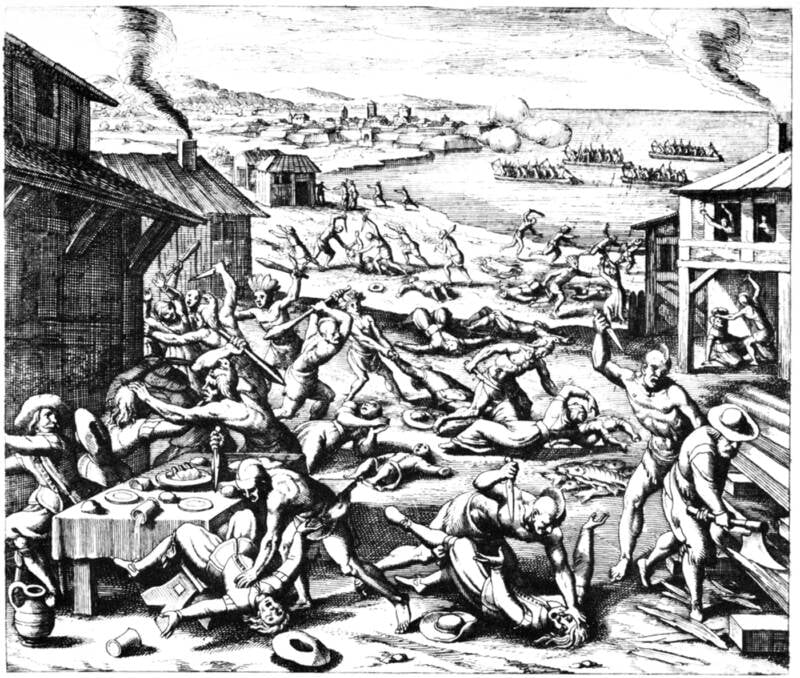
Public DomainThe so-called Indian Massacre of 1622 killed a full quarter of the colonists.
John Rolfe died that same year, around age 37, but it’s unknown if he was killed during the massacre or if he perished from other causes.
This massacre, and other elements of Rolfe and Pocahontas’ relationship, explains why Mike Gabriel, the director of the 1995 Disney film Pocahontas left Rolfe out of his story entirely. Gabriel said, “The story of Pocahontas and Rolfe was too complicated and violent for a youthful audience.”
However, John Rolfe did make an appearance in the film’s direct-to-video sequel Pocahontas II, which was released in 1998. In that movie, Pocahontas travels with John Rolfe to England — but in an effort to prevent war between the Powhatan people and the English. During their harrowing journey, the pair eventually fall in love and share a romantic kiss on their way back to Jamestown together. It’s far more rosy than Pocahontas’ real story.
Pocahontas didn’t live much of a Disney life at all. She was kidnapped, held captive for about a year, possibly raped, and then potentially pushed into marrying a colonist more interested in tobacco plants than her. She may have been coerced into going to England, where she was paraded before curious crowds and possibly murdered before she could return home.
But the full truth of her story is difficult to know. Pocahontas left no written record of her own. Likewise, John Rolfe’s true motivations in marrying Pocahontas have been lost to time. Did he marry for love — or out of an acute business sense and “for the good of this plantation”?
Only John Rolfe and Pocahontas know for sure.
After this look at John Rolfe, the husband of Pocahontas, discover the horrors of the Native American genocide. Then, see some of the most stunning Edward Curtis photos of Native Americans.





